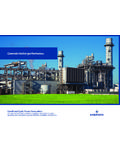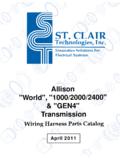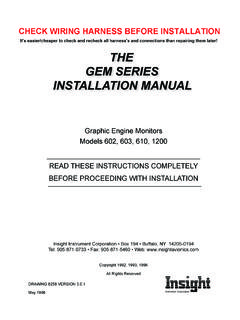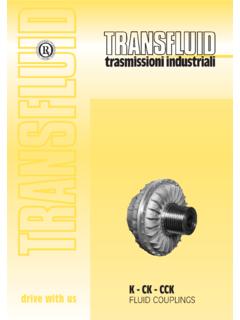Transcription of Liquid Mixing in Agitated Vessels - RESI
1 MULTIPLE IMPELLER GAS- Liquid CONTACTORS1005 Liquid Mixing in Agitated VesselsTo express the degree of Mixing in a stirred vessel , an expression is desirable to showhow far the state of Mixing deviates from the ideal complete Mixing . The most simple andpopular index used in Mixing studies is so called Mixing time. Figure shows the processof Mixing in a stirred vessel . The termination point of this tracer experiment was taken whenthe reponse curve has reached%5%100 CCC)t(Co ( )where C , Co, and C(t) are tracer concentration as the detected point at equilibrium, t=0 andtime t respectively.
2 The time needs to reach the termination state is known as Mixing time of the system under the given condition as shown as tM in Fig..Fig. Process of Mixing and definition of mixingThe role of baffles in a mechanically Agitated vessel is to prevent swirling and vortexingof Liquid and to stabilize the power drawn by the impeller, thus greatly improving the mixingof Liquid . By extending Nagata's (1975) work, Nishikawa et al.(1979) presented a relationshipbetween the number of baffles and Mixing time for single paddle impellers with four and sixblades. They also defined the product of Mixing time and power drawn by the impeller asmixing energy as an index to characterize the Mixing in a mechanically Agitated vessel .
3 Fromtheir results, Nishikawa et al.(1979) pointed out that if the width of the baffle is larger , the fully baffled condition can be obtained if the number of baffle plates exceeds and Hiromoto(1987) have studied the relationship between circulation rate andmixing time for various paddle impellers and have related the Mixing time with the otheroperation variables asLiquid Mixing in Agitated Vessels101 NtM=(NtM) ( )( )where =nbB/T and (NtM) (D/T) (w/T) and Joshi(1982), extending the model proposed by Joshi et al(1982) estimated themixing time of the gassed stirred tank and obtained the following equation to predict mixingtime in a gaased agitatated )gWVDN()NVQ)(DW()DT)(TTaH( +=( )where the constant "a" depended on the size of the circulation loop and was equal to 1 for acentrally located and Hiroo(1983) used the conductivity method to investigate the effect ofgassing on the Mixing efficiency of the Mixing Vessels with single vaned disc turbine and discturbine.
4 They found that under gassing , the Mixing rate was reduced by 20% for the discturbine and by 30% for the vaned disc turbine at low gas flow rates compared with retrospect, it can be seen that little research has been done for the effect of baffledesign on Mixing time in the stirred tank with Rushton impeller under gassing condition in theprevious works. In this chapter, a study using both tracer technique and computer fluiddynamic approach to discuss how the baffle width, baffle number, rotational speed, gassingrate and impeller number will affect the extent of Liquid Mixing in a mechanically agitatedvessel with Rushton turbine Determination of Mixing Time for a Given System by SimulationTo determine the Mixing time under extreme baffle conditions, several rotational speedsand the Mixing time for multiple impellers systems.
5 A numerical simulation program wasdevised to estimate the Mixing time of the system with and without gassing. Thecommercially available computer software "Fluent" was used to simulate the single phaseflow field of the individual Agitated system. During the simulation, the impeller was alwaysconfined in a black box and the boundary conditions were set on the edges of this box. Theboundary conditions including the kinetic energy, radial velocity, tangential velocity andvertical velocity were set after the LDA (Laser Doppler Anemometer) measurements,however the energy dissipasion rate was estimated from an expression proposed by Wu andPatterson (1989) ( =A 3/2/Lres).
6 The - turbulent model was adopted to determined theReynolds stresses. Once the single phase flow field be detennined, the Liquid velocity withgassing can be calculated from the results of Bakker and Van der Akker(1994) as follows: MULTIPLE IMPELLER GAS- Liquid CONTACTORS102Ul,g=Ul,u (Pg/Po) ( )where Ul,g and Ul,u are the Liquid phase velocity with and without gassing, Pg and Po are thepower consumption with and without gassing respectively. Then, the Liquid volumetric flowrate can be calculated as follows:qi,l,g=Ul,g (areai,pro) (1- g) ( )where qi,l,g was the Liquid volumetric flow rate between cells in the i direction, aerai,pro is theprojective area to the t direction and g is the value of local gas hold-up which are obtainedfrom the experimental dat of Jian(1992) and Lin(1994).
7 By using the numerical simulationprogram, the Mixing time of the system under gassed and ungassed conditions can beestimated and the most suitable exponent " ' was found to be 1 by comparing the simulatedmixing time with the expenmental procedures of this simulation is depicted and the details can be found in Wu's thesis(1996).Fig. The flow diagram of the simulated procedure for estimating the Mixing timein gas- Liquid Agitated Mixing in Agitated Vessels103 Table compares the simulated results with the experimental data, from which it canbe seen that the simulation results can agree with the experimental data within a range of 10%deviation under gassed and ungassed Comparison of Mixing time (tM) between experimental and simulatedmethods.
8 Baffle WidthMixing data (sec) data (sec) 0L/mindeviation (%) Effect of Baffle Design on Mixing in Single Impeller System without AerationFigure shows how the width and the number of baffle affect the extent of liquidmixing of the single impeller system under ungassed conditions for N= in term of" Mixing time". The results clearly indicate that insertion of baffles in the system can greatlyimprove the Liquid Mixing even when the ratio of B/T is less than However, the fullybaffled condition is difficult to achieve if the baffle number is less than three, which can beseen from the continuous decay curves for nb= 2 and 3 in this figure.
9 This result is differentfrom what was observed by Nishikawa et al.(1979) for paddle impeller system which statesthat if nb 2 , the fully baffled condition can be obtained. In the systems for which the bafflenumber is more than four, the Mixing time decreases steeply with the increase of the width ofthe baffle first, then it soon reaches a constant value as B/T exceeds It is interesting tonote that this leveling off value tends to decrease as the number of baffles increases in therange of nb< 8 and B/T< This fact implies that within this range, the increase of nb andB/T will improve the extent of Liquid Mixing .
10 However. the simulated results as shown in thefigure by dotted lines also point out that the quality of Liquid Mixing will become worse if nbis more than eight or B/T is larger than The trend of growing worse in Mixing is due tothe localizing effect of excessive baffling. If the same plots are drawn for N= 5 and , itwill be found that the trends of Mixing tune are very similar to However thecontinuous decay of the Mixing time with the increase of baffle width still exists for nb=4 andthe Mixing time does not reach a leveling off value until B/T> and nb 6.







